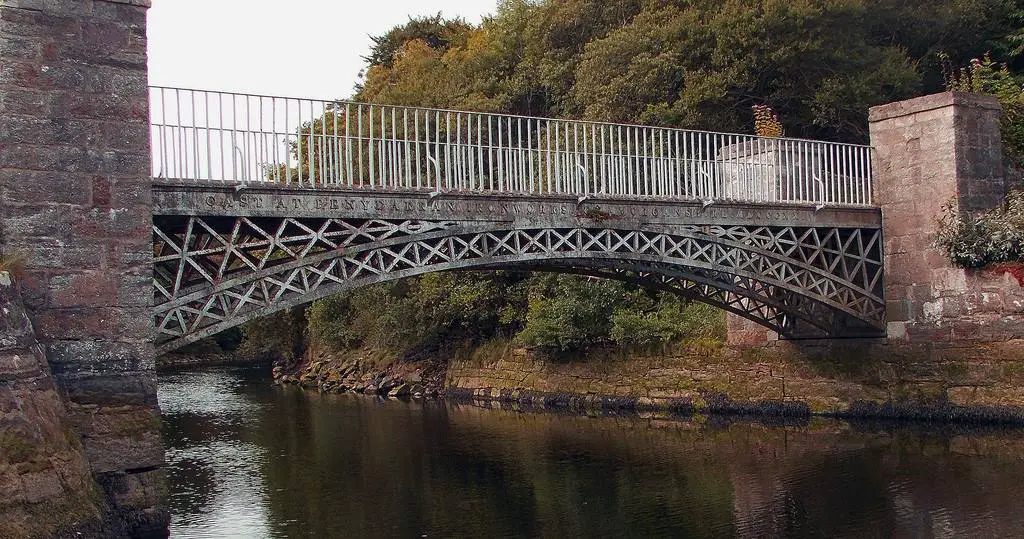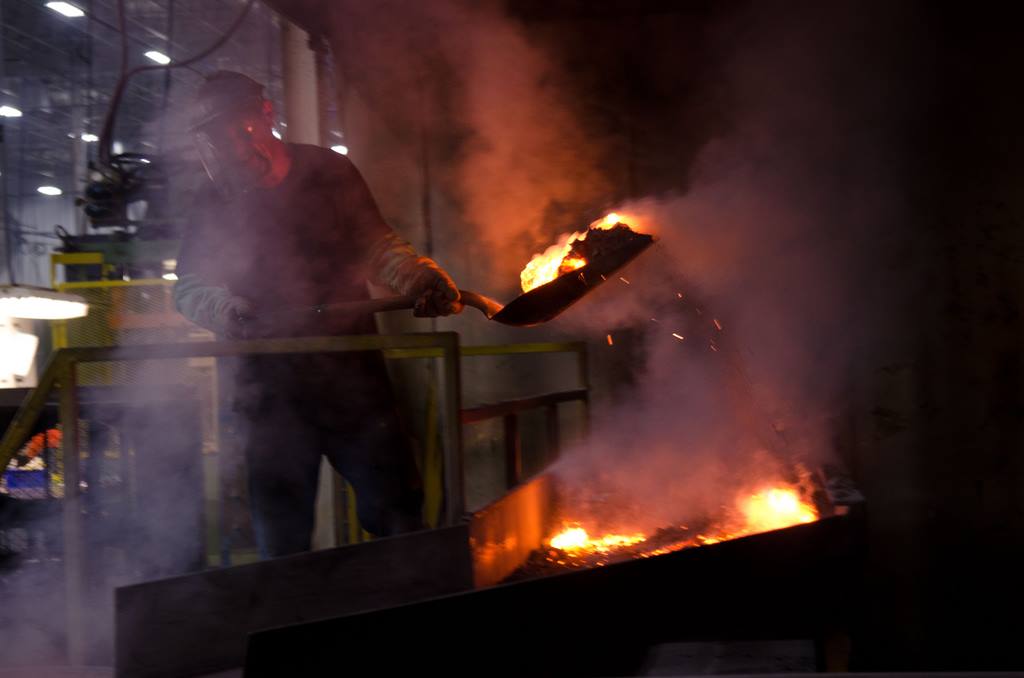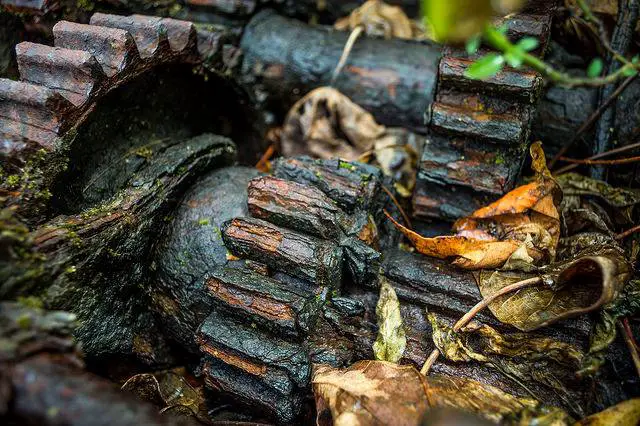
Metals have a combination of strength and plasticity that is not found in many other materials. That’s good to know, but how do we tell the difference between metals? What is the difference between cast iron and steel?
Cast Iron And Steel Carbon Content
The most notable difference between steel and cast iron is the carbon content. Cast iron has a carbon content greater than 2%, while steel has a carbon content of less than 2%, with many steel alloys having less than 1%.
Great, what does that mean in terms of material properties? Read on:
Material Properties Of Steel And Cast Iron
Before I tell you the properties of each material, I must define 4 material science terms:
- Toughness
- Strength
- Ductility
- Hardness
Toughness is the ability of a material to absorb energy without fracturing. Rubber is a tough material. Toughness is a combination of ductility and strength(see below).
Strength is a measure of how much force is needed to bend an object. Steel and cast iron are both strong materials.
Ductility is a measure of a materials ability to undergo plastic transformation without rupturing. Gold is a ductile material.
Hardness is the ability of a material to resist scratching. Diamonds are hard objects.
Rule Of Thumb: Cast iron is harder and stronger, but it’s not as tough (it’s brittle). Steel is not as hard and strong, but it’s tougher.
However, the quick answer I gave above is complicated by heat treatments and alloys.
Heat treatments – How To Get The Best Of Both Worlds
Heat treatments can increase or decrease hardness assuming there is enough carbon in a metal. Some heat treatments allow you to harden parts of the material, while leaving other parts soft(tough).
As a general rule with ferrous(iron) materials, hardness comes at the expense of toughness.
There are a number of heat treatments that can be done to a metal to improve it’s hardness/toughness qualities.
Stress-Relieving Heat Treatment
Sadly, a stress-relieving heat treatment is not a spa treatment, it’s a way of softening a metal without fundamentally changing the micro-structure of a metal. This treatment is done by heating a metal to just below its critical (transformation) point, and then letting that metal cool down slowly over a long period of time.
This process can relieve internal structural stresses in the metal caused from cold working, shearing, or gas cutting.
Annealing Heat Treatment
Unlike the previous treatment, the annealing process requires that the metal be heated to just above its critical point. After which, it is cooled over a long period of time inside the furnace or another heated environment.
Annealing is a more powerful process than stress-relieving, and can cause a change in the crystallization of the metal’s microstructure. This can greatly improve the strength and ductility (toughness) of a metal at the expense of hardness.
Normalizing Heat Treatment
The normalizing process is very similar to annealing, the primary difference is that the stock is allowed to cool outside the furnace at atmospheric temperatures. Due to the faster cool down speed, normalized metal is harder but less tough than annealed metal.
Hardening Treatments
If you have ever seen a blacksmith stick a glowing hot sword into a bucket of water/oil, you have witnessed this process. Much like the softening processes above, the stock is heated to its critical temperature.
After the heating, the stock is quenched in one of the following: water,brine, oil, or liquid nitrogen. Water/brine/oil are all common for alloy steels. Liquid nitrogen or even blasts of cold air may be used for high-alloy materials.
It’s important to note: these treatments only work with metal that has a sufficient level of carbon. There are other methods for low carbon materials, which I will cover later.
Surface Hardening
Earlier I stated: “How to get the best of both worlds.” Surface hardening is one attempt at that. The basic idea of surface hardening, is that you only harden the surface that needs to be hardened. For example:you harden a blade’s edge so that it doesn’t go dull, then you leave the rest of the stock in a less hard and more tough state.
Flame Hardening
As the name suggest, flame hardening involves using an acetylene torch to heat the part of the project that needs to be hardened. While heating a surface, it’s important to move the torch back and forth rapidly at a consistent distance from the surface. This is because you want to avoid hardening the metal at different rates throughout the stock.
Once heated, quench the flame hardened surface just like before.
Induction Hardening
This methods uses a high frequency electrical induction current to heat the metal. A quenching medium follows directly after the induction coil. This method is extremely precise and efficient, and is often used in large scale manufacturing processes.
Laser Hardening
This method uses a laser to rapidly heat up a piece of metal. These lasers are incredibly precise, allowing control over the heating depth as well as the heating area. Most processes that use laser hardening use a shallow depth heat, meaning that no quenching material is needed as the material will quench itself.
Case Hardening
As I mentioned earlier, low carbon steel can’t utilize the primary hardening techniques as these techniques are all ways of rearranging the carbon molecules in the metal. If you are working with a low carbon steel, you must use a different technique like carburizing.
Carburizing
In this method, the steel is heated to just above its critical point while it’s in contact with a carbon rich material. The most common carbon rich agents are : Carbon monoxide, sodium cyanide, and barium carbonate, or hardwood charcoal. Some of these agents are highly toxic,so be very careful in deciding whether they are even necessary. Choose safer options when at all possible, and always exercise caution when using these materials.
The stock is held at this temperature for 15m to one hour, after which it is quenched.

Alloys
In addition to heat treatments, there is another factor complicating my rule of thumb from earlier. Mainly, there are also many different types of steel alloys. An alloy is simply a mixture of metals.
The most common elements found in steel alloys are: Iron, Carbon, Manganese, and silicon. A number of other elements such as copper and lead can be added to some alloys.
Mixing these elements allows a manufacturer to create steels with differing properties. Because you can make some pretty extreme steel alloys, it’s hard to create generalized rules about the difference between cast iron and steel.
There are also a number of undesirable elements that can sneak in during the production process, elements like sulfur and phosphorus. Manufacturers must also keep a lookout for oxides that may form during steel manufacturing.
Why Heat Treatments And Alloys Matter
So why did I take the time to explain all this technical stuff about heat treatment and alloys?
Summed up: Heat treatment and the differing mechanical properties of alloys can make my rule of thumb stated above a little clumsy. The easiest way to overcome this is to look at comparative tables that measure the 3 material properties side by side for each alloy/heat treatment.
You may be hoping that I will provide such a table, sadly this information comes at a high R&D cost, therefore the companies that obtain this information are very protective of it. This information can be found in ASTM manuals and the highly useful Machinery’s Handbook.
Quick Comparison
I think it might be useful to compare cast iron and steel on a number of different factors. As discussed earlier, these are general guidelines. As you now know, heat treatment and alloys can change the character of a metal greatly. Always look up the exact specs of your metal when doing important commercial work.
✯ = winner winner chicken dinner
| Quality | Cast Iron | Cast Steel |
|---|---|---|
| Notch Sensitivity | ✯ | |
| Impact Resistance | ✯ | |
| Ease Of Machining | ✯ | |
| Vibration damping | ✯ | |
| Cost | ✯ | |
| Compressive Strength | ✯ | |
| Wear Resistance | ✯ | ✯ |
| Corrosion Resistance | ✯ | ✯ Stainless Steel |
If you were judging the two materials based purely on the above table, it would seem like cast iron was a clear winner. However this is not really the case, as many real world applications require a tough(non-brittle) material. Hardened steel is very common in many projects as the brittleness of cast iron is real big drawback.
Additional Benefits Of Cast Iron
- Easier To Cast
- Grey Cast Iron Is Cheap To Produce
Additional Disadvantages Of Cast Iron
- Low Tensile Strength
- Low Elongation
Additional Advantage Of Steel
- Greatest Design Flexibility
- Good Weldability
- Short Delivery time
Additional Disadvantages Of Steel
- Bad Shake-Suction
- Harder To Cast
Types Of Cast Iron
Up until now I have tried to compare the difference between cast iron and steel from a very high level. However, because “cast iron” actually refers to a family of alloys, it has been hard for me to be too specific. In order to improve your understanding, I’m going to have to get more granular when examining the question “What Is the Difference Between Cast Iron And Steel?”
Gray Cast Iron
This is a very common form of cast iron. It has relatively few shrinkage cavities and little porosity. Gray cast iron is specified by a two-digit ASTM code. It has a graphitic microstructure and is named after the gray color(graphite) of the fracture it forms. It is the most widely used cast iron based on weight and has a high thermal conductivity making it great for cookware.
This type of cast iron can come in 3 different microstructures:
- Ferritic
- Pearlitic
- Martensitic
Gray Iron is commonly used in the manufacture of:
- Machine Bases
- Engine Blocks
- Electric-motor housings
- Wear surfaces for machines
- Pipes
- Brake Discs & Drums
- Gears
Ductile (Nodular) Iron
This is a type of graphite-rich cast iron that has much more impact and fatigue resistance. These properties come from the shape in which the embedded graphite take on. In Gray Iron, graphite takes on the form of flakes in its microstructure. Meanwhile, In ductile iron, the graphite takes on a nodular shape. This nodular shaped microstructure makes it harder for fractures to occur.
Ductile Iron is used in the manufacture of:
- Crankshafts
- Heavy-Duty Gears
- Pipe
- High-strength Machine Parts
- Wear-resistant Parts

White Cast Iron
This is a type of cast iron that provides incredible hardness at the expense of toughness. This hardness comes from the fact that the carbon in the material organizes itself into cementite rather than graphite.
White cast iron is too brittle for many applications, however it is incredibly handy as a wear surface and is used in the manufacture of:
- Balls And Rings In Coal Pulverisers
- Shell Liners and Lifter Bars in Ball Mills And Autegenous Grinding Mills
- Wear Surfaces Of Slurry Pumps
- Shot Blasting Nozzles
- Rail Road Brake Shoes
- Crushers
Malleable Iron
Malleable Iron is basically annealed white cast iron. During this process the cementite dissociates into iron and graphite, and takes on a microstructure of ferrite or pearlite. This transformation provides more ductility, strength, and shock resistance, hence the name malleable iron.
Malleable Iron is used in the manufacture of:
- Farm And Construction Machinery
- Heavy-Duty Bearings
- Railroad Rolling Stock
Compacted Graphite Iron
Finally we have Compacted Graphite Iron. This material has mechanical and physical properties that put it somewhere in between gray and ductile iron. This iron has damping and thermal properties that are similar to gray iron, and strength and stiffness comparable to ductile iron.
Due to this strength, objects made with compacted graphite iron can be made thinner and lighter. It has better machinability than ductile iron, and is easy to cast. It is used in the manufacture of:
- Engine Blocks
- Cylinder Heads
- Turbo Housings
- Exhaust Manifolds
Microstructures
Ferrite, Pearlite, Martinsite, microstructures…what?
I know I kind of just dropped the terms in the article without really explaining them and that’s annoying. Taking the time to explain them in depth would make this article waaaaay too long. For now, just take in the idea that the atoms of any given material organize themselves into shapes. These shapes greatly affect the material properties of a given material.
Conclusion.
In this article I did my best to give general guidelines that can help you figure out what the difference is between cast iron and steel. These guidelines are crude however, as cast iron and cast steel are terms that actually refer to a bunch of a different materials.
I tried to provide some detail, and to give the scientific underpinnings for the differences between the two materials. Sadly, I’m limited in how thorough I can be in an internet article. There are entire 300+ page textbooks on metallurgy and manufacturing that go into much greater depth than I did here.
Interested in some practical applications of this knowledge? Check out my article on Blacksmith Anvils, where I go over the pro’s and con’s of cast iron anvils vs cast steel anvils.